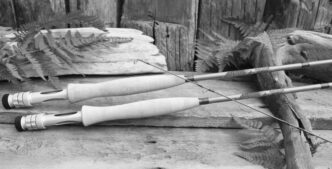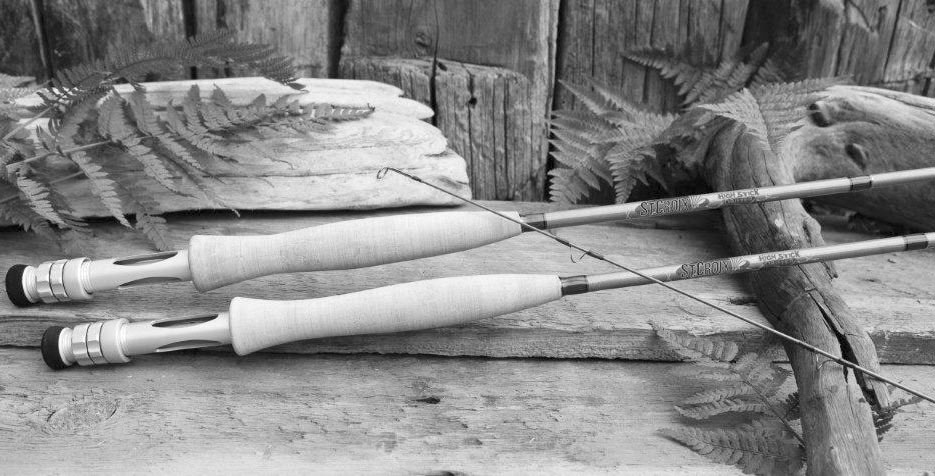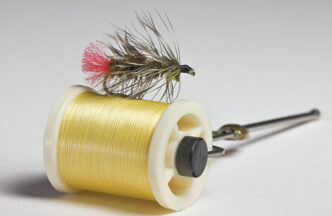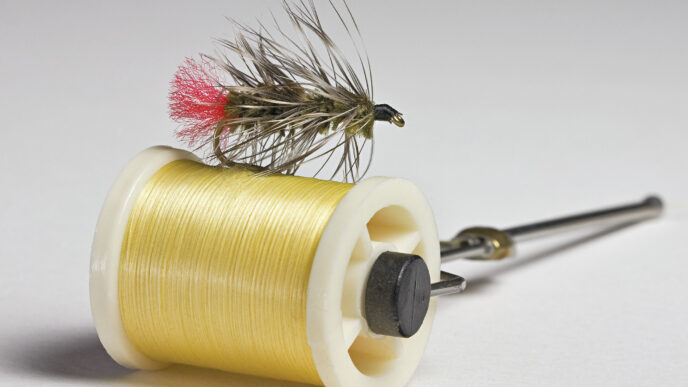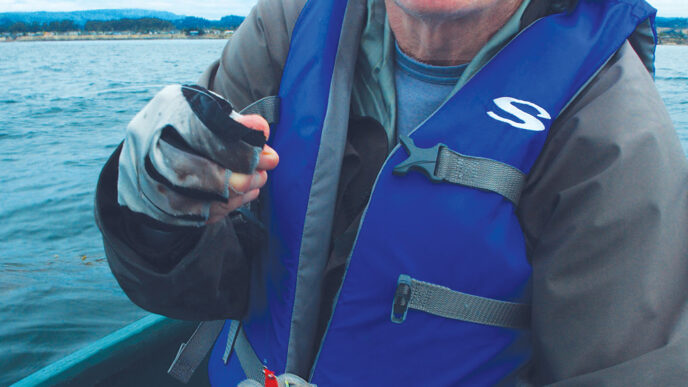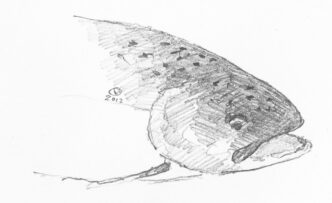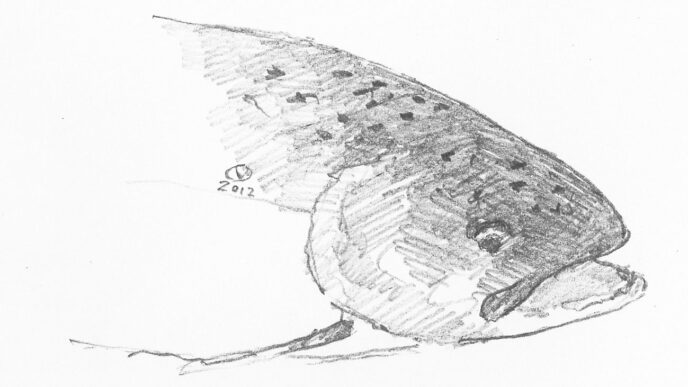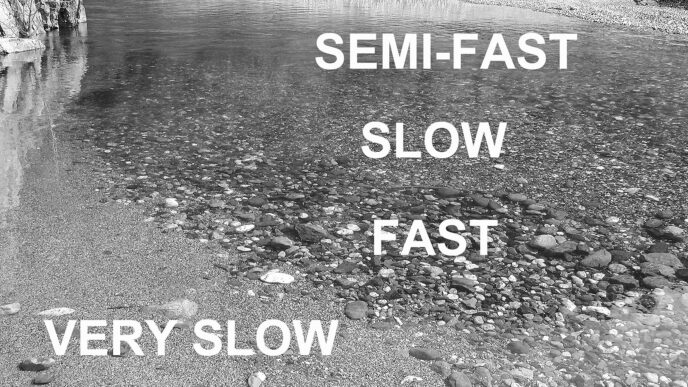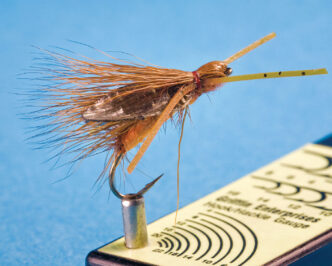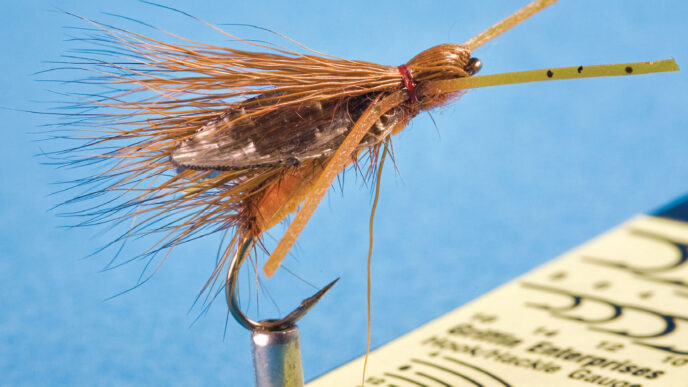The fly-fishing industry traditionally holds its trade show and announces new products in the fall, but buying patterns and sourcing deadlines for imported goods haven’t agreed with tradition of late, and that’s led to earlier releases. Of course, if that also means getting a jump on the competition as your reps visit dealers or exploiting a press vacuum by announcing early, what’s not to like? So while I’ll be walking the aisles of the International Fly Tackle Dealer Expo in mid-August, there are a few new products that have already been released this spring and summer that deserve mention.
Rods
St. Croix’s new nymph rod was announced last year and made it to dealers this spring. The High Stick Drifter series, like St. Croix’s earlier streamer rods, was designed with the input of Madison River guru Kelly Galloup. In one sense, these rods represent St. Croix’s entry into a market niche that Sage, Scott, and others began exploring in 2010: specialty rods designed for fishing two nymphs, an indicator, and a couple of split shot — indicator rods, in short — and they’ve done pretty well. And while St. Croix’s High Stick Drifters are similar to these others, they’re also different. First off, two of the three four-piece models for 4-weight and 5-weight lines are full 10-footers, which is a bit longer than the norm, though there’s a 9-foot 6-inch 4-weight, if the longer length unsettles you. Kelly Galloup, in a video on the St, Croix website (http://stcroixrods.com/product/highstickdrifter), describes them as being designed more for repetitive casting of a fixed length of line, rather than for the extended-drift, line-mending style that other makers are pushing: “The way you really fish” is how he puts it.
The emphasis here is on roll casting, and while there’s a light tip to protect tippets on strikes (made from St. Croix’s version of the ultrastrong new 3M resin system that Hardy and Loomis also use), High Stick Drifters are full-flex rods, rather than rods with increased resistance in the butt section. The western grip, at seven inches, is a bit longer than normal and sits above an uplocking reel seat with the now common dirt-catching cutouts in the barrel. The hook keeper, in what seems to me a clever move, has been moved up off the front of the grip to a position just below the second stripping guide. That not only saves your fingers from unintentional gashes, but lets you wrap a leader around the base of the reel and hook the fly safely where you can grab it and still have the end of the fly line out of the tip top. Time will tell if it also catches line while casting. The snake guides are lightweight titanium Recoil models; the cosmetics are conservative, but handsome shades of gray; and the price is a reasonable $430 — not the least expensive stick in the store, but by no means the priciest.
Temple Fork Outfitters has expanded its Finesse series into the category of tiny rods with its Half Weight model. This one’s just 5 feet long, 1.2 ounces, and built in three sections, so it packs down to just 22 inches. It’s designed to handle 1-weight or 2-weight lines (though of course that makes you wonder why it’s called a Half Weight), and TFO sees us fishing it for the small species — the brookies and bluegills — that form a universal collective memory for fly fishers. At $159.95, if it takes you back to the days when a 6-inch trout was a trophy, it’s going to be a lot less expensive and more fun than a therapist. TFO even has a new reel to go with it — the BVK “0” click pawl model at $149.95. The TFO website is http://www.templeforkflyrods.com.
Reel Things
Staying at least nominally on our trout theme, Abel just introduced a brook trout reel finish, based on a likeness by Montana artist Derek DeYoung. You can special order the brook trout finish on any Abel reel at an additional cost of $200 (it’s $250 if you want the drag knob covered, as well.) That’s pricey, but according to Abel’s Don Swanson, it takes Abel factory artists more than six hours to paint each DeYoung brook trout flank pattern on a reel. I’ve yet to see one of the strikingly decorated reels that Abel sells actually being fished on the water, much less tossed into the back of the vans or trucks or boats that take me fishing, so I’m guessing they’re mostly going to the collectible market. And why not?
Abel also announced a new Super 9/10N (for narrow) reel, a companion to the previously released 7/8N. At 4.2 inches in diameter and 0.9 inches wide, it will hold a 9-weight line with 225 yards of 20-pound backing or a 10-weight with 175 yards of 30-pound Dacron. Substitute 50pound Spectra, and the capacity increases to 350 yards with a 10-weight line. Frames and spools are made from cold-rolled 6061-T650 aircraft-grade aluminum and are anodized for corrosion resistance using the tackle manufacturer’s time-tested proprietary methods.
Along with extensive field testing in fast-fish destinations, Abel says it proved the staying power of the reel’s pure cork drag system by running reels on a lathe for extensive periods of time at various drag settings. Finally, to please anglers who like to hear a reel make some noise when a fish runs, the Super 9/10N utilizes Abel’s new 303 stainless steel sealed-cartridge outgoing-click mechanism, the same outgoingclick system that has been installed for more than two years in their Super Series Quick Change reels. You’ll pay $825 for the reel and $370 for extra spools. The Abel Web site is http://www.abelreels.
Lines
RIO Products recently announced the addition of two new major technological upgrades. Described by RIO as “sophisticated and radical,” MaxFloat and MaxCast are being added to three of the company’s trout lines, RIO Gold, RIO Grand, and RIO Trout LT.
MaxCast is a hydrophobic line coating that actively pushes water away from the line. The result, says RIO, is radically improved floatation and reduced dirt adhesion. The formulation also contains a blend of permanent “slickening” agents that continuously migrate to the line’s exterior for enhanced shooting and durability. MaxFloat is RIO’s solution to the problem of a fly line tip sinking because its smaller diameter contains less coating than the rest of the line. MaxFloat places maximum floatation at the tip and allows the tip to float “more than twice as high as regular line tips without an increase in diameter.” All three lines with the upgraded coatings (Gold, Grand, and Trout LT) retail for $74.95. It’s not too hard to predict that we’ll see more RIO lines using these technologies in the future.
RIO also announced the new Skagit Flight VersiTip, a complete package for Skagit casting. Skagit-style gear is designed to handle large flies fished deep, and Skagit lines combine a light running line with relatively short, tapered floating heads that are looped to heavy sink tips. It’s astonishing how easily they handle on double-handed rods and some single-handers.
The problem for many anglers, however, is to find the right balance between rod, shooting line, head, and tips. Skagit Flight VersiTip is Rio’s answer to that dilemma. Each box contains a Skagit Flight shooting head, an appropriate diameter floating Powerflex-core shooting line, and three appropriately sized Skagit MOW Tips; 10-foot floating, 5-foot floating / 5-foot sinking and 10-foot sinking. The MOW tips (named after Skagit innovators Mike McCune, Scott O’Donnell and Ed Ward) are weighted so they perform the same, despite different lengths and densities. The end result, according to RIO, is a perfectly balanced Skagit outfit. All the lines in the Skagit Flight VersiTip series have front and back welded loops for quick rigging and a printed line-size identifier on the rear loop. They’re available in six different head weights, from 400 to 650 grains, and list for $159.95. The RIO Web site is http://www.rioproducts.com.
Royal Wulff has added a couple of models to their popular Ambush Triangle Taper series. There are now 9-weight to 14-weight floating lines for single-handed and shorter double-handed rods and 5-weight, 6-weight, and 7-weight versions with 20-foot clear intermediate tips. Both series feature a color change from a thin running line to either blue (for floating) or clear (for intermediate) at the end of the head and have loops at either end. They’re priced at $74.95. The Royal Wulff Web site is http://www.royalwulff.com.

Tippets
Scientific Anglers recently announced new tippet material packaged in three distinctive new tippet spools that let you sort gear more easily. The new material is available in a freshwater nylon polymer formulated for suppleness, low memory, and strength, packaged on a hi-vis green plastic spool, in a saltwater hard nylon polymer formulated for powerful presentation, packaged on a blue spool, and in a fluorocarbon polymer formulated for low visibility, abrasion resistance, and knot strength, packaged on a bright yellow-orange spool. The spools are all UV shielded, and they have built-in line cutters and an interlocking hub that allow spools to be joined together easily, yet lets them spin freely when stripping off tippet. At 32 yards, the spools offer somewhat more material than most other brands. Freshwater and saltwater spools cost $4.99, while the fluoro is $17.50. The Scientific Anglers Web site is http://www.scientificanglers.com.
Soft Goods
The Buff neck gaiter has pretty much named, not to mention owned, its narrow, but popular product category. “Didja bring a Buff?” means “Do you have a quick-dry, high-SPF, breathable stretch fabric tube that you can slide over your head to wear as a scarf or a mask to protect your face, neck, and ears from sun and wind?” You see them everywhere these days, so it’s not surprising that other manufacturers have become interested in what I guess now has to be called the head-and-neck-gaiter niche. Simms’s new Sun Armor Saltwater Gaiter is a very sensible reworking of the basic idea. As opposed to the simple tube shape of the Buff, Simms has given their version an anatomical fit, skinnier in the middle than at top and bottom. They’ve also lengthened the tube so it’s tall enough at the back neck to fit over a fishing cap, provided breathing holes at the front, and made the bottom longer at both front and back for better sun coverage. The color is either a green or blue camo and the retail price is $39.95. The Simms website is http://www.simmsfishing.com.
Buff, of course, wasn’t satisfied with discovering and owning the market in neck gaiters. What else, their designers wondered, was usually left uncovered when fishing? The hands, of course. And although there are a number of good sun gloves on the market that do the job well (those by Glacier Glove and Cam Sigler, for example), the Buff folks went full-tilt boogie into design mode. “Take that, all you other glove designers,” seems to be part of the message. So in addition to an SPF 50 protective rating, Buff Angler Gloves feature anatomical thumbs, an extended cuff, fingertip pulls for easier on/off, a Kevlar stripping guard, ergonomically shaped palms and fingers, accordionlike pleats at the fingers to provide better grip and less hand fatigue, and a Diamond Grip palm. These are some gloves.
They come in two camo patterns that I’d call “light” and “dark” and are priced at $39.95 a pair. The Buff website is http://www.buffusa.com.
Sage has expanded into the performance apparel category for 2012. I mentioned the sleek and lightweight Quest Ultra Light Rain Shell in the March/April issue, and later that same month, Sage announced a handful of new technical garments. I particularly like the look of the Quest Softshell Insulated Jacket and Quest Softshell Insulated Hoody ($250 and $175, respectively) which combine a treated, durably water-repellant four-waystretch fabric with Primaloft insulation in the body, but none in the arms, leaving you unencumbered for active rowing and casting. They come in black and a rust red that Sage calls “canyon” for the hoody and in black and a moss green that Sage calls “canopy” for the jacket. There’s also a midlayer top that looks good enough to wear on the command deck of the starship Enterprise, the Kanektok Wool Pro Half-Zip ($125), which combines Polartec Power Dry fabric with wool. Available in gold, black, and blue, it’s warm, machine washable, and feels nice enough on your skin that you might not need a base layer. For the warmer end of the temperature spectrum there’s a 30 SPF Keys Crew ($45) with long, narrow sleeves that won’t flap around and thumb loops for back-of-hand protection, in case you’re not wearing gloves. They come in pale green (I mean, of course, “equator”), gray (which is to say “fog”) and “offshore blue.” The Sage website is http://www.sageflyfish.com.
Hardware
Headlamps have pretty much replaced flashlights in most of my friends’ vests and gear bags, largely because they keep your hands free for holding rods, pulling oars, or climbing up brushy hillsides. Petzl has been a leader in that product category and now has designed a nifty unit that takes “hands free” to the next level. The Petzl Nao is a variable-power unit with a microprocessor that reacts to changing light conditions and to the point at which the beam is focused. Shift from looking down a trail to reading a map, and the unit decreases the power and the spread of the beam to illuminate just the map. Aim back way down the trail or at a point just a bit ahead of your feet, and the beam automatically readjusts to show what the lamp’s aimed at. Since light output varies between 7 and 355 lumens, depending on the illumination requirements of different aim points, you spend less burn time at high light levels and thus extend battery life. The Nao is water resistant, rechargeable, programmable via software and a USB hookup, and has a manually activated pulse mode for emergencies. It’s pricey at $175, but true gearheads aren’t going to care. The Nao page on the Petzl website is outdoor/headlamp/nao.
And since I’m in techy mode, it seems fair to mention the ultimate accessory for social-media-addicted anglers. GoPro’s digital cameras have been around for a while. They let you strap a high-quality unit to your head, the bow of your boat, or darn near anything else, record your adventures, and taunt or brag to the six or seven thousand “Friends” you’ve acquired. The basic Hero model (starting at $199.99) uses a rechargeable lithium battery, captures 170-degree wide-angle 720p video and 127-degree semiwide-angle 1080p video, plus 5-megapixel photos. It comes with a compact housing that makes it waterproof to almost 200 feet. Now there’s a new Hero2 model ($299.99) that ups the ante to 11 megapixels and full 170-degree wide-angle 1080p video and 11 megapixel photos at 10 photos per second. SD cards and all sorts of software to keep you connected are available as options. Go forth now and record. The GoPro Web site is http://www.gopro.com.
Let’s close with something for rod builders. Most rods today use guides sourced in Asia, and that’s fine, because the quality is decent. But the picky rod crafter willing to pay more for exceptional quality now has another source in Snake Brand Guides of Battle Ground, Washington. Snake Brand’s Original series of snake guides and tip tops are of the highest quality stainless steel, with uniform feet that don’t need grinding before wrapping, and are plated beautifully in chrome, black nickel, or bronze finishes that are hard and long lasting. They cost four times as much as imported snakes, but the quality is more consistent, they’re easier to use, and the plating is better. Snake Brand guidemeister Mike McCoy recently came up with an interesting innovation on the basic snake guide in his Universal series of snake guides. Universals have a tapered tip on the foot for easier wrap starts and a unique concave radius on the bottom of the foot that gives them a lower profile. That makes them better fit the geometry of tubular blanks and also makes them self-aligning. Even spendier than the Original Series, they’re available only in chrome and black nickel and are gaining ground with the pickiest of builders. The Snake Brand Web site is http://www.snakeguides.com.



